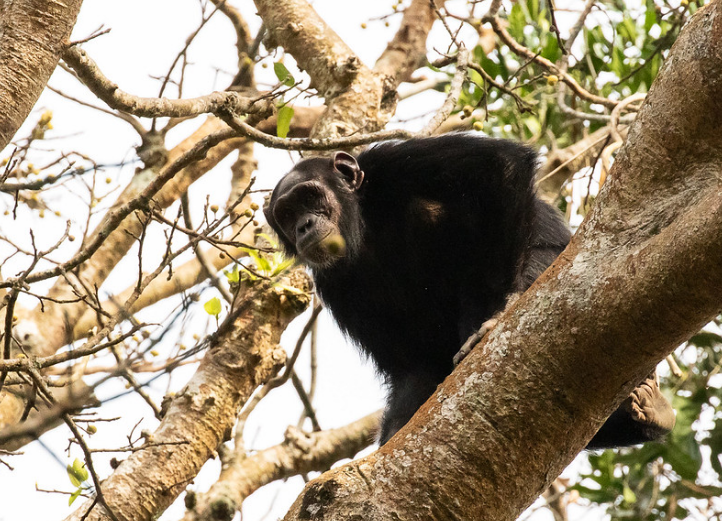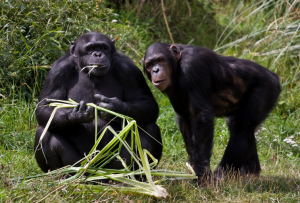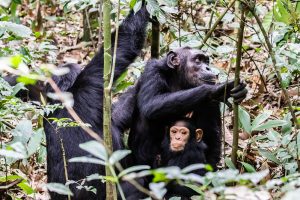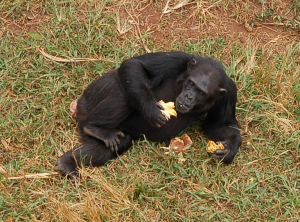
Chimpanzee Tracking Safaris : The Chimpanzee (Pan troglodytes) are species of great ape native to the forests Africa. Chimpanzees are more closely related to humans thus known as our relatives since they share 1.4% of our DNA. However, the primary threats to chimpanzees are habitat destruction, hunting and disease.
What you need to know about chimpanzees
 Appearance and Physiology
Appearance and Physiology
Firstly, the arms of a chimpanzee are longer than its legs, and can reach below the knees. Secondly, the hands have long fingers with short thumbs and flat fingernails. Thirdly, a chimpanzee’s head is rounded with a prominent and prognathous face. Lastly, have forward facing eyes, a small nose and rounded non-lobed ears. Chimpanzee bodies are covered by coarse hair, except for the face, fingers and toes, palms of the hands and soles of the feet. More so, chimps lose more hair as they age and develop bald spots. The hair of a chimp is typically black or ginger but as they grow older, white or grey patches may appear. The skin may range from pale to dark. Adult males weigh between 40-60 kg with females weighing between 27-50 kg.
Hunting
When hunting small monkeys such as the red colobus, chimpanzees hunt where the forest canopy is interrupted or irregular. This allows them to easily corner the monkeys when chasing them in the appropriate direction. Chimps may also hunt as a coordinated team, so that they can corner their prey even in a continuous canopy.
Tool usage

Nearly all chimpanzee populations have been recorded using tools. They modify sticks, rocks, grass and leaves and use them when foraging for honey, termites, ants, nuts and water. They also use stones to smash open tasty nuts and apply leaves as sponges to soak up drinking water.
Attacks
Surprisingly, common chimpanzees have attacked humans. In Uganda, several attacks on children have happened of which some of them are fatal. Some of these attacks may be due to the chimpanzees being intoxicated (from alcohol obtained from rural brewing operations). Human interactions with chimpanzees may be especially dangerous if the chimpanzees perceive humans as potential rivals.
Status and conservation
They are also taken, often illegally, for the pet trade, and are hunted for medicinal purposes in some areas. Farmers sometimes kill chimpanzees that threaten their crops while others are unintentionally killed by snares meant for other animals. Additionally, infectious diseases are a main cause of death for chimpanzees. They succumb to many diseases that afflict humans because the two species are so similar. As human populations grow, so does the risk of disease transmission between humans and chimpanzees.
Communication
Chimpanzees use facial expressions, postures and sounds to communicate with each other. Chimps have expressive faces which are important in close-up communications. When frightened a “full closed grin” causes nearby individuals to be fearful, as well. While travelling, chimps keep in contact by beating their hands and feet against the trunks of large trees, an act known as “drumming”. They also do this when encountering individuals from other communities.
Mating and parenting

Chimpanzees mate throughout the year, although the number of females in oestrus varies seasonally in a group. In fact, their gestation period is about eight months. Females will reach reproductive maturity by age of 13 and usually gives birth to one baby. Care for the young is provided mostly by their mothers whereby they provide their young with food, warmth and protection. Newborn chimps are helpless and their grasping reflex is not strong enough to support them for more than a few seconds. When they reach five to six months, infants ride on their mothers’ backs. When they reach two years of age, they are able to move and sit independently. At three years, infants move further away from their mothers. By four to six years, chimps are weaned and infancy ends.
Behavior
At the core of social structures are males, which roam around, protect group members, and search for food. Males remain in their natal communities while females generally emigrate at adolescence. As such, males in a community are more likely to be related to one another than females. Common chimpanzees live in communities that typically range from 20 to more than 150 members. They generally spend most of their time travelling in small, temporary groups consisting of a few individuals. Although they normally walk on all fours (knuckle-walking), chimpanzees can stand and walk upright.
Mortality and health
Chimpanzees may react to a leopard’s presence with loud vocalizing, branch shaking and throwing objects. The average lifespan of a chimpanzee is usually less than 15 years. Wild individuals may live over 27 years and occasionally over 60. Captive chimps live longer with median lifespans of 31.7 years for males and 38.7 years for females. Captive chimps have been recorded to live up to 63 years.
Diet
 Chimps prefer fruit to other food items but also eat leaves, leaf buds, seeds, blossoms and stems. Female chimpanzees appears to consume much less animal flesh than males, according to several studies. Chimpanzees do not appear to directly compete with gorillas in areas where they overlap. When fruit is abundant, gorilla and chimp diets converge but diverge when fruit is scarce. The two apes may also feed on different species, whether fruit or insects.
Chimps prefer fruit to other food items but also eat leaves, leaf buds, seeds, blossoms and stems. Female chimpanzees appears to consume much less animal flesh than males, according to several studies. Chimpanzees do not appear to directly compete with gorillas in areas where they overlap. When fruit is abundant, gorilla and chimp diets converge but diverge when fruit is scarce. The two apes may also feed on different species, whether fruit or insects.
Ecology
The common chimpanzee is a highly adaptable species and lives in a variety of habitats. These include dry savanna, evergreen rainforest, montane forest, swamp forest and dry woodland -savanna mosaic. The chimpanzee makes a night nest in a tree in a new location every night. However, every chimpanzee sleeps in a separate nest other than infants or juveniles that sleep with their mothers.
FREQUENTLY ASKED QUESTIONS
How long do chimpanzees live?
Chimpanzee lifespan in the wild is harder to gauge. However, a recent study indicates that the average lifespan of a chimpanzee is around 38 to 40 years. In captivity a female can live up to 39 years old while a male can live up to 32 years old.
What do chimpanzees eat?
Chimpanzees are omnivorous, but eat fruit more than anything else. Most of a chimpanzee’s diet comes from our bits of plants (seeds, leaves, roots, resin etc.) but they will also eat insects, honey, birds and bird eggs, mammals and even soil.
Where do chimpanzees live?
As a highly adaptable species, chimpanzees inhabit a range of habitats. These include tropical rainforest, montane rainforests, less densely vegetated and even dry savannah.
Where can you find Chimpanzees in Uganda?
In Uganda you can track chimpanzees in Kibale Forest National Park and Queen Elizabeth National Park. We also have chimps in Ngamba Island Sanctuary which is a home of orphaned chimpanzees.
How strong are chimpanzees?
Chimpanzees are enormously strong, estimated to be around four times stronger than a human of a similar size. They can reach speeds of 25mph (40kph) when running. Their arms are designed to swing them through the trees. They have a much higher proportion of fast-twitch muscle fibers. These seems to be what gives chimpanzees their extraordinary strength.
Do chimpanzees live in groups?
The chimpanzees live in groups which range in size from 15 to 150 members. Chimpanzees live in fission-fusion societies, meaning that the size and composition of their social groups changes over time. They spend the majority of their time in small temporary groups. The groups consists of just a few individuals known as ‘parties’ but also associate with a wider group known as a ‘community’.
Can chimpanzee use tools?
Chimpanzees are one of the few animals that are known to use tools. This includes the use of sticks to retrieve termites from their mounds. The stones to open up appetizing nut contents as well as leaf-sponges to soak up drinking water.
Can chimpanzees communicate?
Chimpanzees make around 30 different vocalizations. The most common and loudest is the pant-hoot, a long-distance call used for a variety of social reasons. But more so particularly for keeping in touch with fellow troop members.
When do chimps reproduce?
The chimpanzee has a gestation period of eight months. The infant is weaned at about three years old, but usually maintains a close relationship with its mother. Females will reach reproductive maturity by age 13 and can give birth at any time of the year. Chimpanzees exhibit large pink sexual swellings on their behinds which advertise their fertility to prospective mates. Chimpanzees usually give birth to just one infant and once born the infant will cling tightly to its mother’s fur. They would later take rides on her back until two years of age.
Can chimps walk on two legs?
Chimpanzees get around by climbing and swinging through trees. They usually walk on all fours (knuckles-walking) but can also walk upright on two feet if they want to.
How clever are chimpanzees?
As well as using tools, some chimpanzees have been able to learn basic human sign language.
Chimpanzee tracking places in Uganda
Kibale National Park
Generally, Kibale National Park is favored for chimpanzee tracking and nature walks. Its not only due to its endowment with wildlife but also its relatively flat terrain that is easy to trek. The Park is also well optimized for trekking with well laid out trail networks.
Kyambura Gorge Queen Elizabeth National Park
Kyambura Gorge is renowned for its primate population and the only place with habituated chimpanzees in Queen Elizabeth National Park. Other notable primates one can also view in kyambura Gorge are the red-tailed monkey, black-and-white colobus among others.
Ngamba Island Chimpanzee Sanctuary
Not only provides a safe haven for these vulnerable chimpanzees but also creates an opportunity for a memorable chimpanzee experience. The Island is now open for visitors all year around. It has now become one of the must-visit adventure destinations in Uganda. For those seeking a quick but satisfactory chimpanzee experience, this is the best place. It’s a perfect alternative to the strenuous but more adventurous Chimpanzee tracking are in the big parks and reserves.
Chimpanzee Tracking Rules
- Chimpanzees can catch your diseases; you must not enter the forest if you are sick.
- Do not leave litter in the forest.
- If you need to urinate or defecate, do so off the trail. Bury your waste in a hole (30cm deep) along with any toilet paper.
- Keep as quite as possible in the forest, you will see more.
- Keep at least 8 meters (25 feet) from the chimpanzees at all times.
- Do not mimic chimpanzee’s vocalization (you do not know what you might be saying!)
- Do not eat near the chimpanzees.
- Do not chase the chimpanzees.
- Do not use flash photography.







